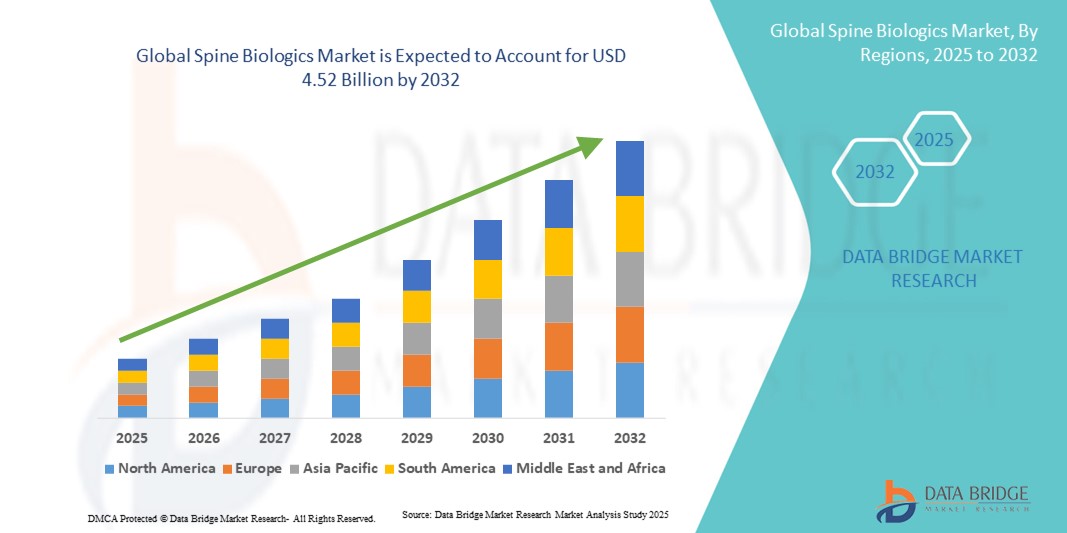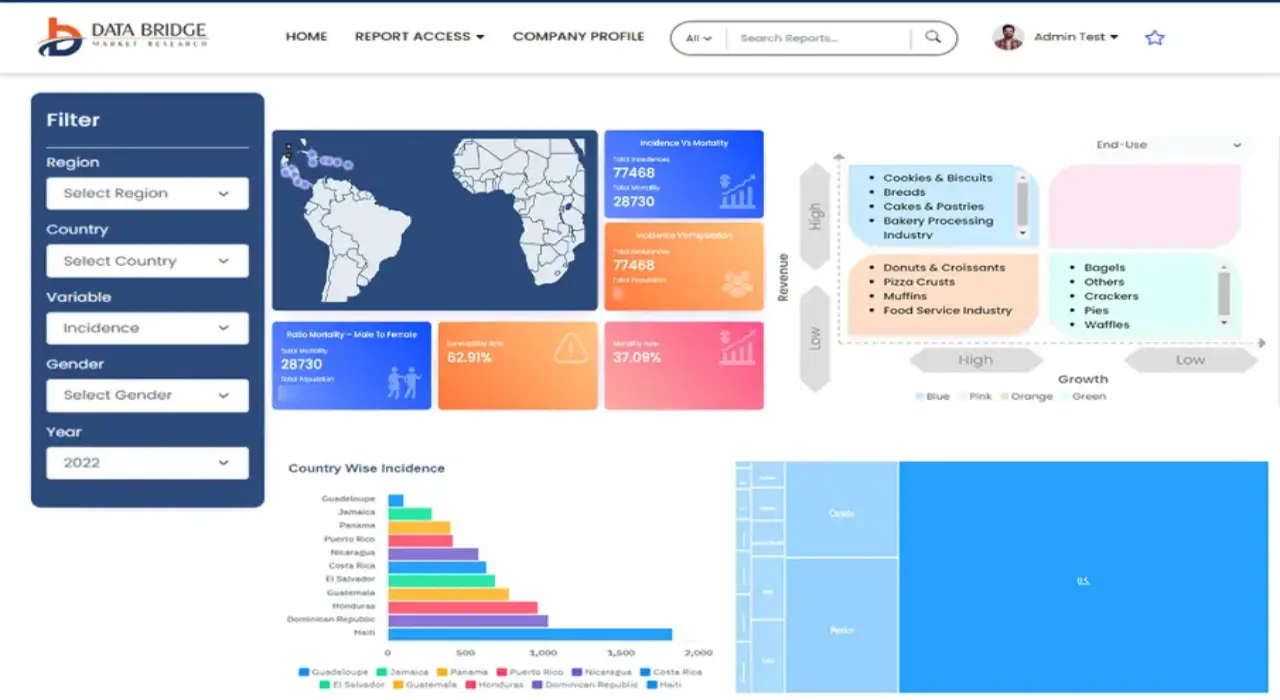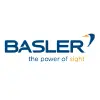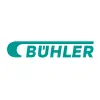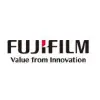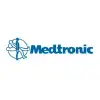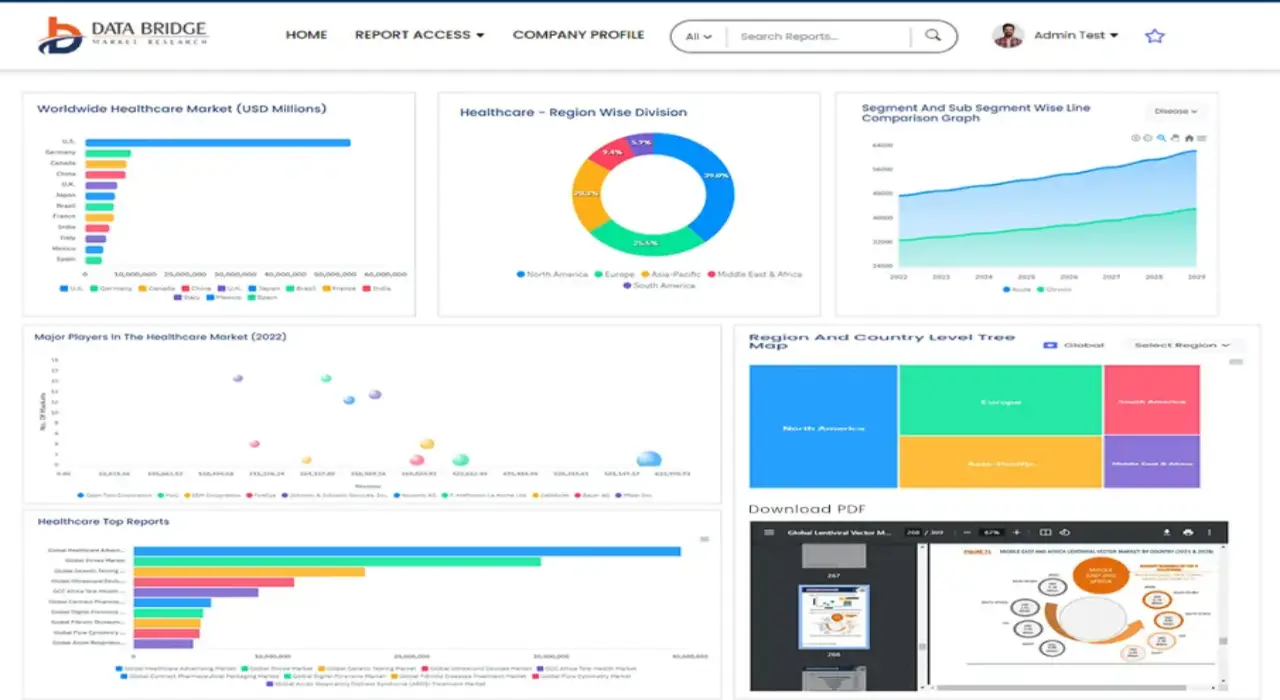Global Spine Biologics Market
Market Size in USD Billion
CAGR :
% 
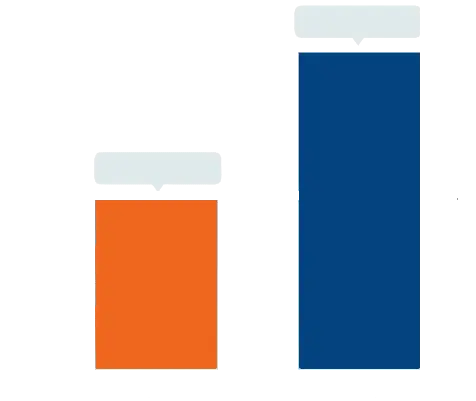 USD
3.30 Billion
USD
4.52 Billion
2024
2032
USD
3.30 Billion
USD
4.52 Billion
2024
2032
| 2025 –2032 | |
| USD 3.30 Billion | |
| USD 4.52 Billion | |
|
|
|
|
Global Spine Biologics Market Segmentation, By Product (Bone Allografts, Bone Graft Substitute, Platelet Rich Plasma, and Bone Marrow Aspirate Therapy), Surgery Type (Anterior Cervical Discectomy and Fusion (ACDF), Transforamenal Lumbar Interbody Fusion (TLIF), Anterior Lumbar Interbody Fusion (ALIF), and Lateral Lumbar Interbody Fusion (LLIF)), End-User (Hospitals, Spinal Surgery Centers, Orthopedic Clinics, and Others) - Industry Trends and Forecast to 2032
Spine Biologics Market Size
- The global spine biologics market size was valued at USD 3.30 billion in 2024 and is expected to reach USD 4.52 billion by 2032, at a CAGR of 4.03% during the forecast period
- The market growth is primarily driven by the increasing prevalence of spinal disorders, rising adoption of advanced surgical procedures, and continuous innovations in biologic materials for spinal fusion and repair
- Moreover, growing awareness among healthcare providers and patients regarding minimally invasive spine surgeries, coupled with the demand for enhanced clinical outcomes, is positioning spine biologics as a preferred solution in spinal care. These factors collectively are propelling the adoption of spine biologic products, thereby significantly boosting the industry's growth
Spine Biologics Market Analysis
- Spine biologics, encompassing materials such as bone graft substitutes, demineralized bone matrix, and growth factors, are increasingly essential in spinal fusion and regenerative procedures due to their ability to enhance bone healing, reduce recovery times, and improve surgical outcomes in both degenerative and trauma-related spinal conditions
- The rising demand for spine biologics is largely driven by the growing prevalence of spinal disorders, increasing adoption of minimally invasive spine surgeries, and continuous innovations in biologic materials that offer improved safety and efficacy
- North America dominated the spine biologics market with the largest revenue share of 43% in 2024, supported by high healthcare expenditure, well-established spine care infrastructure, and strong presence of key market players, with the U.S. witnessing significant uptake of advanced biologics in spinal fusion procedures, fueled by clinical evidence, surgeon preference, and reimbursement support
- Asia-Pacific is projected to be the fastest-growing region in the spine biologics market during the forecast period due to increasing incidence of spinal disorders, expanding healthcare infrastructure, and rising awareness of advanced spine care solutions
- Bone graft substitutes segment led the spine biologics market with a market share of 44.6% in 2024, driven by their proven efficacy, wide clinical adoption, and versatility across various spinal procedures
Report Scope and Spine Biologics Market Segmentation
|
Attributes |
Spine Biologics Key Market Insights |
|
Segments Covered |
|
|
Countries Covered |
North America
Europe
Asia-Pacific
Middle East and Africa
South America
|
|
Key Market Players |
|
|
Market Opportunities |
|
|
Value Added Data Infosets |
In addition to the insights on market scenarios such as market value, growth rate, segmentation, geographical coverage, and major players, the market reports curated by the Data Bridge Market Research also include in-depth expert analysis, pricing analysis, brand share analysis, consumer survey, demography analysis, supply chain analysis, value chain analysis, raw material/consumables overview, vendor selection criteria, PESTLE Analysis, Porter Analysis, and regulatory framework. |
Spine Biologics Market Trends
Advancements in Biologics and Regenerative Technologies
- A notable and accelerating trend in the global spine biologics market is the development of advanced biologic materials such as recombinant proteins, stem cell-based products, and synthetic bone graft substitutes that enhance spinal fusion outcomes and tissue regeneration
- For instance, bone morphogenetic protein (BMP)-based grafts are being increasingly used in complex spinal fusion surgeries to improve bone healing rates and reduce recovery time. Similarly, synthetic hydroxyapatite scaffolds are being integrated into minimally invasive procedures to support vertebral repair
- Innovations in biologics enable features such as enhanced osteoinduction, faster graft incorporation, and improved patient-specific outcomes. For instance, some demineralized bone matrix products are engineered to optimize growth factor release and promote faster spinal fusion. Furthermore, these biologics can be customized for use in degenerative, trauma-related, or deformity-corrective procedures
- The seamless integration of advanced spine biologics with surgical instrumentation, navigation systems, and minimally invasive techniques facilitates improved procedural efficiency and better post-operative outcomes. Surgeons can now achieve precise graft placement, reduced operative time, and optimized spinal alignment
- This trend towards more effective, patient-specific, and integrated biologic solutions is fundamentally transforming surgical expectations in spinal care. Consequently, companies such as Medtronic and Globus Medical are developing next-generation biologics with enhanced regenerative properties and compatibility with minimally invasive techniques
- The demand for advanced spine biologics that offer superior fusion outcomes and integration with modern surgical methods is growing rapidly across both hospital and outpatient surgical settings, as clinicians increasingly prioritize efficacy and patient recovery
Spine Biologics Market Dynamics
Driver
Rising Prevalence of Spinal Disorders and Minimally Invasive Surgeries
- The increasing incidence of degenerative spinal diseases, trauma cases, and spinal deformities, coupled with the growing adoption of minimally invasive surgical techniques, is a key driver for the heightened demand for spine biologics
- For instance, in March 2024, Medtronic announced an expansion of its biologics portfolio targeting complex spinal fusion procedures, aiming to integrate advanced graft materials with minimally invasive technologies. Such initiatives by leading companies are expected to drive spine biologics market growth in the forecast period
- As awareness among surgeons and patients about the benefits of biologics grows, products offering faster fusion, reduced complication rates, and enhanced bone regeneration are increasingly preferred over traditional grafts
- Furthermore, the rising adoption of minimally invasive spine surgeries and outpatient procedures is creating demand for biologics that are easy to handle, deliver consistent results, and reduce operative time
- The ability of spine biologics to improve post-surgical outcomes, reduce recovery periods, and complement advanced instrumentation and surgical navigation systems are key factors propelling adoption in hospitals and specialty clinics. The trend towards evidence-based spine care and increasing insurance reimbursement for biologics further contributes to market growth
Restraint/Challenge
High Costs and Regulatory Compliance Hurdles
- Concerns regarding the high cost of advanced spine biologics and stringent regulatory requirements for product approval pose significant challenges to market expansion. As biologics require extensive clinical trials and regulatory clearance, the development timeline and investment are substantial, limiting accessibility in some regions
- For instance, high-profile delays in regulatory approvals for novel recombinant proteins have made some hospitals cautious about rapid adoption of new biologics in spinal procedures
- Addressing these challenges through strategic partnerships, cost-optimization, and adherence to international regulatory standards is crucial for market growth. Companies such as DePuy Synthes and Stryker emphasize compliance with FDA and CE regulations while offering training programs to surgeons for safe and effective use. In addition, the relatively high price of biologics compared to autografts or traditional bone grafts can restrict adoption in cost-sensitive healthcare systems, particularly in emerging economies
- While insurance coverage and hospital procurement strategies are gradually improving, the perceived premium for advanced biologics can still hinder widespread adoption among smaller healthcare providers
- Overcoming these challenges through improved cost-efficiency, streamlined regulatory approvals, and enhanced clinician education on clinical benefits will be vital for sustained growth in the spine biologics market
Spine Biologics Market Scope
The market is segmented on the basis of product, surgery type, and end-user.
- By Product
On the basis of product, the spine biologics market is segmented into bone allografts, bone graft substitutes, platelet-rich plasma (PRP), and bone marrow aspirate therapy (BMA). The bone graft substitutes segment dominated the market with the largest market revenue share of 44.6% in 2024, driven by their proven efficacy in spinal fusion, wide clinical adoption, and versatility across multiple spinal procedures. Surgeons prefer bone graft substitutes due to their predictable performance, reduced risk of disease transmission compared to allografts, and availability in diverse formulations that cater to specific patient needs. In addition, ongoing innovations in synthetic and bioactive graft materials further enhance their effectiveness and appeal. The bone graft substitutes segment also benefits from strong support in minimally invasive surgeries where handling autografts or allografts may be challenging. Hospitals and spinal surgery centers particularly favor these products for their ease of use, consistency, and ability to support faster recovery.
The PRP segment is anticipated to witness the fastest growth rate of 20.5% from 2025 to 2032, fueled by increasing interest in regenerative therapies and autologous biologics for spinal repair. PRP is gaining traction due to its potential to promote bone healing, reduce inflammation, and enhance tissue regeneration without the risks associated with donor-derived grafts. Its minimally invasive nature and ability to complement surgical procedures make it attractive to both surgeons and patients. The rising adoption of personalized medicine approaches further accelerates the use of PRP, particularly in outpatient spinal clinics and specialized centers. Ongoing clinical research demonstrating improved fusion rates and postoperative recovery is expected to sustain PRP’s rapid growth trajectory.
- By Surgery Type
On the basis of surgery type, the spine biologics market is segmented into anterior cervical discectomy and fusion (ACDF), transforaminal lumbar interbody fusion (TLIF), anterior lumbar interbody fusion (ALIF), and lateral lumbar interbody fusion (LLIF). The TLIF segment dominated the market with the largest market revenue share of 39.8% in 2024, due to its widespread use in lumbar spinal disorders and compatibility with a variety of biologic products. TLIF procedures are preferred for their ability to provide stable fusion and restore spinal alignment while minimizing neurological risks. Spine biologics play a critical role in enhancing fusion success, particularly in multilevel or revision surgeries. Hospitals and specialized spinal centers rely on TLIF procedures combined with bone graft substitutes or allografts to improve patient outcomes. Increasing surgeon preference for TLIF in both degenerative and trauma-related cases further supports the segment’s dominance.
The LLIF segment is expected to witness the fastest CAGR of 21.2% from 2025 to 2032, driven by rising adoption of minimally invasive lateral approaches for lumbar fusion. LLIF offers advantages such as reduced muscle disruption, shorter recovery times, and better sagittal balance correction, making it attractive for both surgeons and patients. The growing availability of biologics that are easy to deliver and integrate into LLIF procedures further fuels adoption. Surgeons increasingly prefer LLIF for complex deformity and multi-level cases, which supports demand for compatible biologic products. The expansion of minimally invasive spine programs in emerging markets is expected to accelerate LLIF adoption and associated biologics use.
- By End-User
On the basis of end-user, the spine biologics market is segmented into hospitals, spinal surgery centers, orthopedic clinics, and others. The hospitals segment dominated the market with the largest revenue share of 47.5% in 2024, owing to the high volume of spinal procedures performed in hospital settings and the availability of comprehensive surgical infrastructure. Hospitals offer access to advanced biologics, trained surgeons, and specialized equipment required for complex fusion procedures. They also benefit from insurance coverage and reimbursement for biologic products, encouraging adoption. The preference for hospitals is reinforced by the need for multidisciplinary teams and post-operative monitoring, ensuring optimal patient outcomes. Large hospital networks and teaching hospitals contribute significantly to the demand for spine biologics due to the focus on advanced spine care and research initiatives.
The spinal surgery centers segment is anticipated to witness the fastest growth rate of 19.8% from 2025 to 2032, driven by the increasing trend of outpatient and minimally invasive spinal procedures. Specialized centers focus on efficiency, shorter recovery times, and patient-centric care, making them ideal settings for adopting advanced biologics. Surgeons in these centers prefer biologics that are easy to handle, offer predictable outcomes, and integrate seamlessly with minimally invasive techniques. Rising awareness among patients about outpatient options and faster rehabilitation further accelerates adoption in these centers. The growing number of dedicated spine surgery centers in North America and Asia-Pacific is expected to sustain the rapid growth of this segment.
Spine Biologics Market Regional Analysis
- North America dominated the spine biologics market with the largest revenue share of 43% in 2024, supported by high healthcare expenditure, well-established spine care infrastructure, and strong presence of key market players, with the U.S. witnessing significant uptake of advanced biologics in spinal fusion procedures, fueled by clinical evidence, surgeon preference, and reimbursement support
- Healthcare providers and surgeons in the region increasingly prefer advanced biologics such as bone graft substitutes and allografts due to their proven efficacy, safety, and ability to improve surgical outcomes in complex spinal fusion procedures
- This widespread adoption is further supported by high healthcare expenditure, well-established reimbursement systems, and a strong presence of key market players, establishing spine biologics as the preferred choice for spinal fusion and regenerative procedures across hospitals and specialized spine centers
U.S. Spine Biologics Market Insight
The U.S. spine biologics market captured the largest revenue share of 80% in 2024 within North America, driven by the high prevalence of spinal disorders and the widespread adoption of advanced spinal fusion procedures. Surgeons increasingly prefer biologics such as bone graft substitutes and allografts for their proven efficacy, safety, and ability to enhance post-surgical outcomes. The growing trend of minimally invasive spine surgeries, combined with rising patient awareness and insurance coverage for biologics, further propels the market. Moreover, the integration of innovative biologic products with modern surgical techniques and navigation systems is significantly contributing to market expansion.
Europe Spine Biologics Market Insight
The Europe spine biologics market is projected to expand at a substantial CAGR throughout the forecast period, primarily driven by the rising incidence of degenerative spinal conditions and increasing adoption of advanced spinal care solutions. Growing urbanization, coupled with improved healthcare infrastructure and reimbursement support, is fostering the use of biologics. European surgeons and hospitals are increasingly utilizing biologics in complex spinal fusion procedures to improve patient outcomes. The region is witnessing significant growth across hospitals and specialized spine surgery centers, with biologics being incorporated into both new procedures and revision surgeries.
U.K. Spine Biologics Market Insight
The U.K. spine biologics market is anticipated to grow at a noteworthy CAGR during the forecast period, driven by increasing spinal disorder prevalence and a preference for minimally invasive procedures. In addition, the focus on improved surgical outcomes and faster patient recovery is encouraging healthcare providers to adopt biologic solutions. The U.K.’s robust healthcare infrastructure, combined with rising awareness among surgeons and patients regarding advanced spinal therapies, is expected to stimulate market growth.
Germany Spine Biologics Market Insight
The Germany spine biologics market is expected to expand at a considerable CAGR during the forecast period, fueled by growing awareness of regenerative therapies and the demand for technologically advanced spinal care solutions. Germany’s strong healthcare system, focus on innovation, and emphasis on clinical evidence promote the adoption of biologics, particularly in hospitals and specialized spinal centers. The integration of biologics with modern surgical techniques and minimally invasive procedures is becoming increasingly prevalent, aligning with the country’s high standards for patient safety and surgical efficacy.
Asia-Pacific Spine Biologics Market Insight
The Asia-Pacific spine biologics market is poised to grow at the fastest CAGR of 23.5% during the forecast period of 2025 to 2032, driven by increasing prevalence of spinal disorders, rising healthcare expenditure, and rapid adoption of minimally invasive surgeries in countries such as China, Japan, and India. The region’s growing focus on advanced spine care, supported by government initiatives to improve healthcare infrastructure, is driving the adoption of spine biologics. Furthermore, as APAC emerges as a hub for spinal procedure innovations and biologic product manufacturing, the accessibility and affordability of spine biologics are expanding to a wider patient population.
Japan Spine Biologics Market Insight
The Japan spine biologics market is gaining momentum due to the country’s aging population, high prevalence of degenerative spinal conditions, and demand for advanced surgical solutions. Japanese surgeons increasingly prefer biologics such as bone graft substitutes and autologous therapies for their ability to improve fusion rates and reduce recovery time. Integration with minimally invasive spinal procedures and advanced surgical technologies is fueling growth. Moreover, rising awareness among patients regarding enhanced post-surgical outcomes is encouraging the adoption of spine biologics in both hospital and outpatient settings.
India Spine Biologics Market Insight
The India spine biologics market accounted for the largest revenue share in Asia-Pacific in 2024, attributed to the country’s rising incidence of spinal disorders, growing middle class, and expanding healthcare infrastructure. India is witnessing increasing adoption of advanced spinal fusion procedures, with hospitals and specialized surgical centers incorporating biologics into standard treatment protocols. The push towards improved surgical outcomes, combined with the availability of cost-effective biologic products and strong domestic manufacturing, are key factors propelling market growth in India.
Spine Biologics Market Share
The Spine Biologics industry is primarily led by well-established companies, including:
- Medtronic (Ireland)
- Medical Device Business Services, Inc (U.S.)
- Stryker (U.S.)
- Zimmer Biomet (U.S.)
- NuVasive®, Inc. (U.S.)
- Orthofix Medical Inc (U.S.)
- Arthrex, Inc. (U.S.)
- Exactech, Inc. (U.S.)
- Organogenesis Inc. (U.S.)
- Xtant Medical (U.S.)
- Globus Medical (U.S.)
- SeaSpine (U.S.)
- Spinal Elements, Inc (U.S.)
- Spine Wave, Inc. (U.S.)
- Biosenic SA (France)
- BioHorizons (U.S.)
- B. Braun SE (Germany)
- Baxter (U.S.)
What are the Recent Developments in Global Spine Biologics Market?
- In July 2025, Orthofix announced the full U.S. commercial launch of the Reef™ L Interbody System for lateral lumbar fusion procedures. This innovative system incorporates proprietary NanoMetalene™ surface technology and unique Reef undercuts to enhance surgical precision and patient outcomes
- In May 2025, Xtant Medical introduced OsteoFactor Pro™, a naturally derived, growth factor-rich formulation designed to enhance the biologic activity and regenerative potential of bone grafts in spine fusion procedures. This product aims to improve healing outcomes and reduce recovery times for patients undergoing spinal surgeries
- In October 2024, Theradaptive's OsteoAdapt™ SP received the Gold Level Award for Best Technology in Spine 2024 by Orthopedics This Week. OsteoAdapt™ SP is an investigational device utilizing Theradaptive's protein therapeutics platform for spine and orthopedic applications
- In September 2024, Bioretec's RemeOs biodegradable spinal interbody cage received FDA clearance. RemeOs is intended to restore intervertebral height and facilitate intervertebral body fusion in the cervical spine, absorbing into bone and assisting in the healing process
- In June 2024, Bone Biologics Corporation announced the treatment of the first two patients in a pilot clinical study of its NB1 bone graft device intended for spine fusion procedures. The NB1 device aims to provide an alternative to traditional bone grafts, potentially reducing complications and improving fusion rates
SKU-
Get online access to the report on the World's First Market Intelligence Cloud
- Interactive Data Analysis Dashboard
- Company Analysis Dashboard for high growth potential opportunities
- Research Analyst Access for customization & queries
- Competitor Analysis with Interactive dashboard
- Latest News, Updates & Trend analysis
- Harness the Power of Benchmark Analysis for Comprehensive Competitor Tracking
Research Methodology
Data collection and base year analysis are done using data collection modules with large sample sizes. The stage includes obtaining market information or related data through various sources and strategies. It includes examining and planning all the data acquired from the past in advance. It likewise envelops the examination of information inconsistencies seen across different information sources. The market data is analysed and estimated using market statistical and coherent models. Also, market share analysis and key trend analysis are the major success factors in the market report. To know more, please request an analyst call or drop down your inquiry.
The key research methodology used by DBMR research team is data triangulation which involves data mining, analysis of the impact of data variables on the market and primary (industry expert) validation. Data models include Vendor Positioning Grid, Market Time Line Analysis, Market Overview and Guide, Company Positioning Grid, Patent Analysis, Pricing Analysis, Company Market Share Analysis, Standards of Measurement, Global versus Regional and Vendor Share Analysis. To know more about the research methodology, drop in an inquiry to speak to our industry experts.
Customization Available
Data Bridge Market Research is a leader in advanced formative research. We take pride in servicing our existing and new customers with data and analysis that match and suits their goal. The report can be customized to include price trend analysis of target brands understanding the market for additional countries (ask for the list of countries), clinical trial results data, literature review, refurbished market and product base analysis. Market analysis of target competitors can be analyzed from technology-based analysis to market portfolio strategies. We can add as many competitors that you require data about in the format and data style you are looking for. Our team of analysts can also provide you data in crude raw excel files pivot tables (Fact book) or can assist you in creating presentations from the data sets available in the report.

